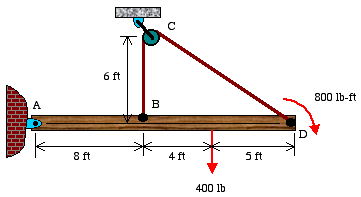Example 7: For the beam and loading shown, determine the tension in the cable and the support reactions at A. Neglect the size of the pulley at C.

Example 7: For the beam and loading shown, determine the tension in the cable and the support reactions at A. Neglect the size of the pulley at C.

Solution: We begin the analysis by first drawing the free-body diagram of the beam. We remove the support A to reveal the reaction forces at that point. We also cut the cable at B and D to reveal the tension force in the cable.

 . Summing moments about point A gives
. Summing moments about point A gives

The horizontal component of tension at D passes through point A, hence, it does not appear in the moment equation. Solving the above equation for T gives

Having found the tension in the cable, we can now find the reaction forces at A by using the two force equilibrium equations.

The negative sign in front of RAy indicates that it is directed in the opposite direction to that shown in the FBD.